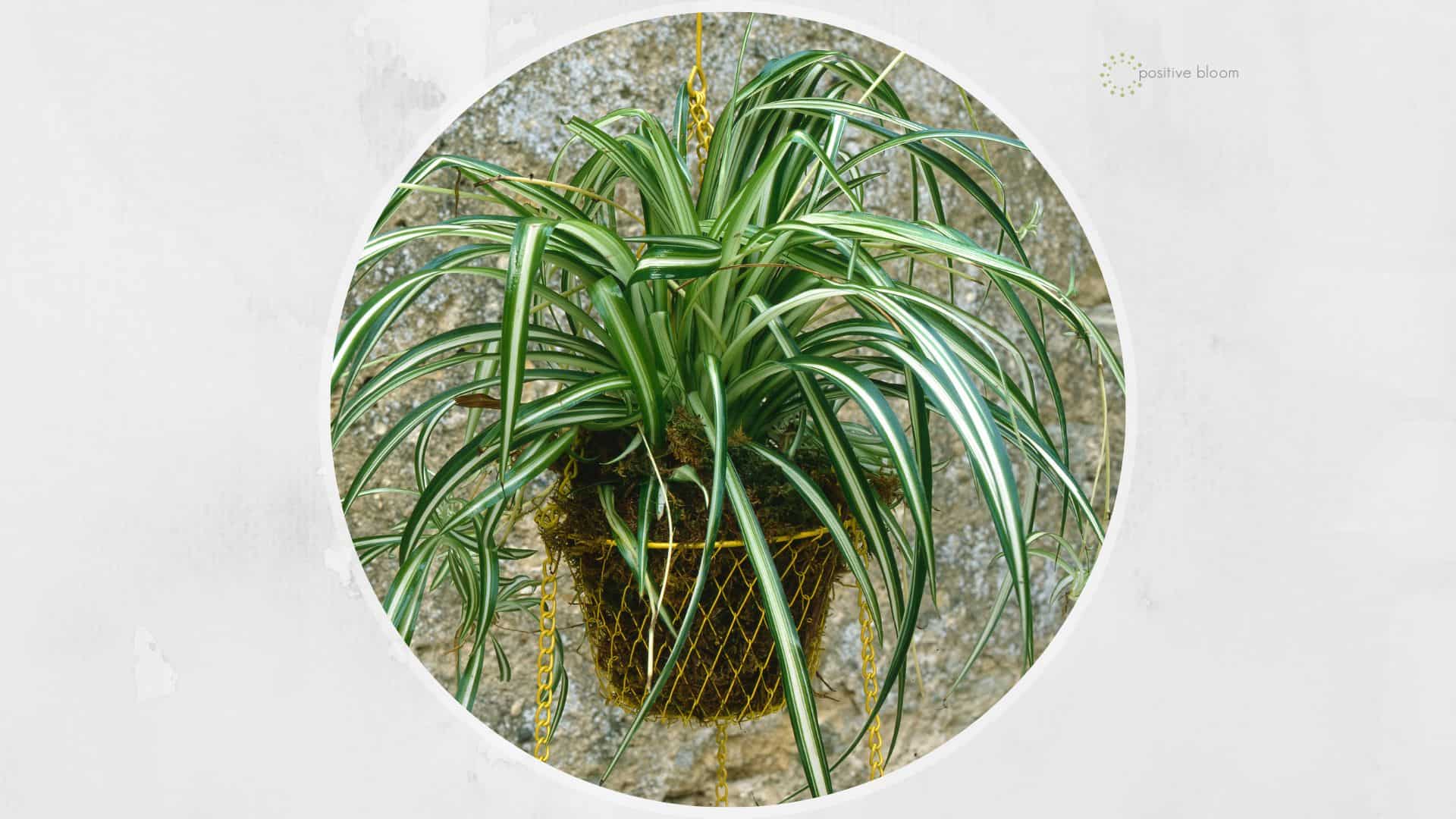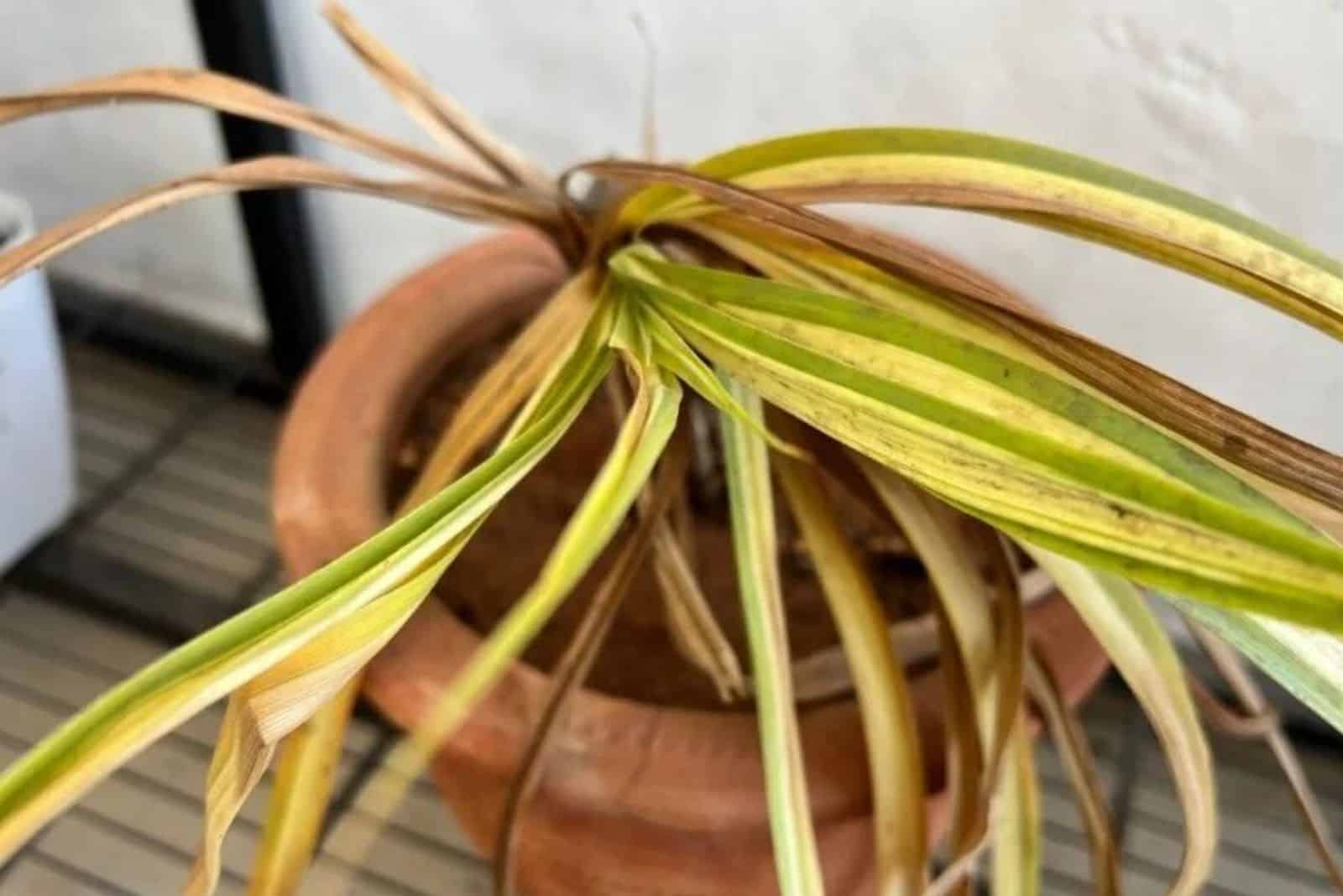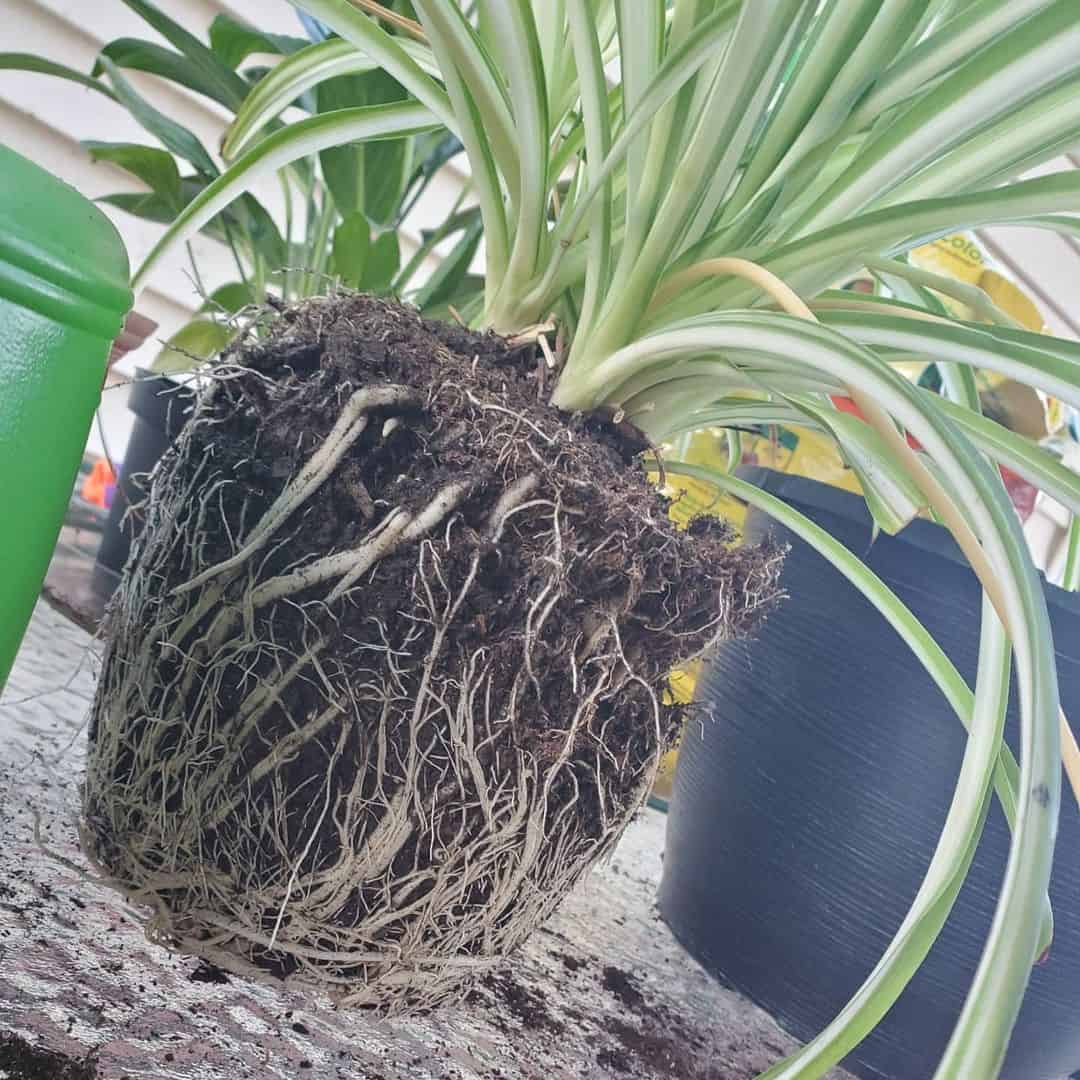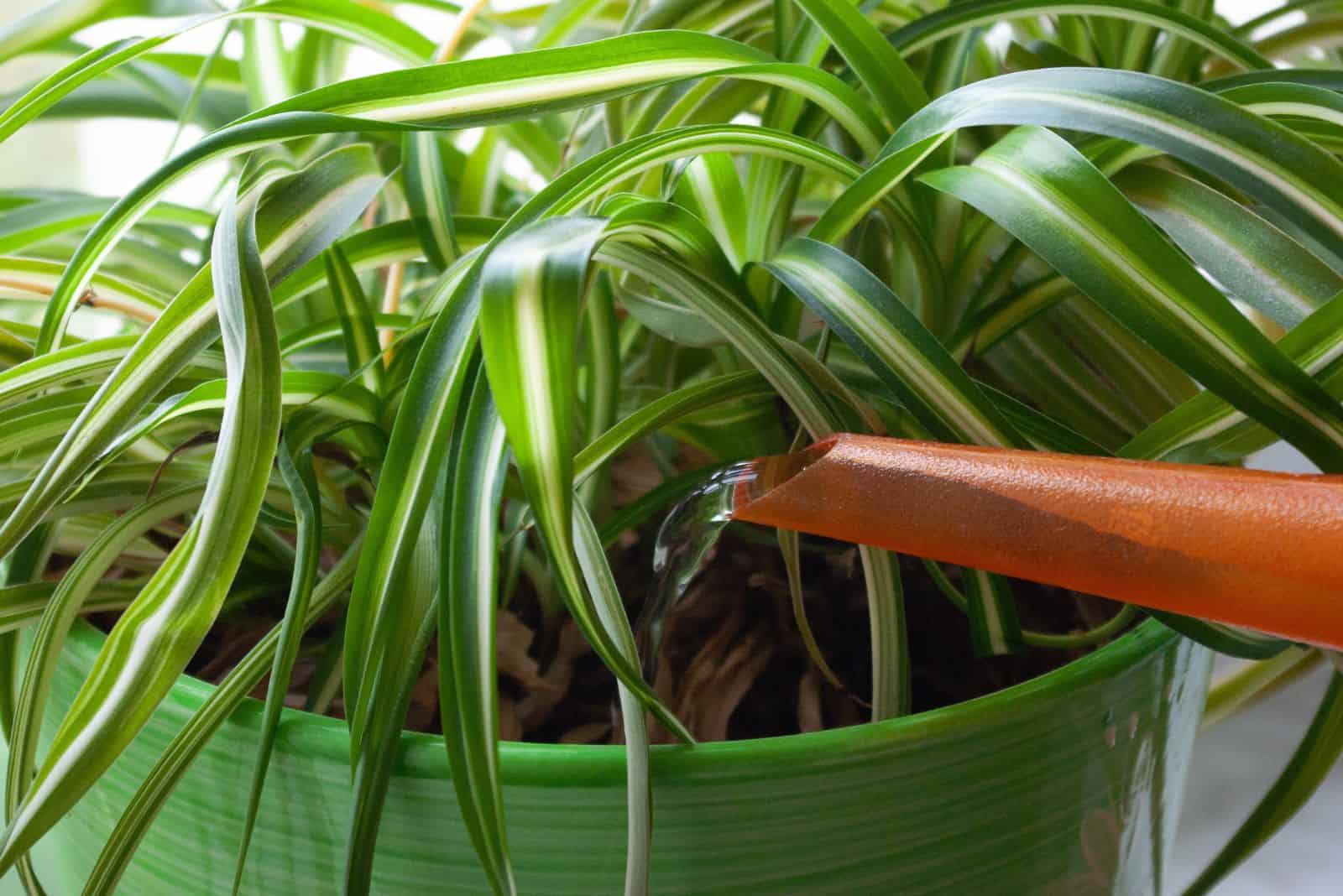Spider plants don’t require much watering; however, many gardeners aren’t aware of this, so Spider plants often end up overwatered. Too much watering will make the soil all soggy and saturated, which prevents normal nutrient and oxygen uptake. Your plant will end up suffocating as a result, which must be avoided at all costs!
These plants are known for their remarkable oxygen production capabilities [1], but they still need oxygen to survive!
Spider root rot is one of the worst outcomes of overwatering. Root rot is usually caused by Fusarium fungi, which can survive for about 2-3 years in the soil [2]. Besides fungi, pests are often attracted to soggy soils.
In today’s article, we are going to cover the common signs of an overwatered spider plant, as well as the ways to fix these issues.
Let’s start with some basic info about spider plants:
[table id=704 /]
Let’s dive in!
Signs That You’ve Overwatered Your Spider Plant
If you have been overwatering your plants, they will find some ways to tell you. Let’s take a look at the most common signs of an overwatered spider plant.
1. Yellowing of Leaves
There are several reasons why Spider plant leaves turn yellow. You can tell if overwatering is to blame for the yellowing by taking into consideration the age and placement of the leaves.
The elder leaves nearest to the topsoil should be examined. The bottom leaves of the plant should be the first to get food and water from the roots. Of course, if the roots can’t absorb water and nutrients normally due to waterlogged soil, they also can’t send nutrients to the other parts of the plant.
This ultimately leads to yellowing of the leaves, which is a biological process referred to as leaf chlorosis and necrosis [3].
If you keep watering your plant, it will display more and more of these yellow leaves. Overwatering is often accompanied by root rot, and yellow leaves are also a symptom of this fungal disease. Check below if you suspect your spider plant has root rot.
2. Brown Spots on Leaves
The margins of the leaves becoming brown are another indicator of an overwatered spider plant. Brown dots on leaves are frequently caused by low humidity and bugs. However, they might also be signs of overwatering, which is why you should check the soil moisture first.
What is happening to the plant in this case?
The plant cells enlarge and form leaf blisters because they are drowning. In the leaf cells, turgor (water pressure) builds up and causes rupturing. Blisters are followed by brown blotches known as leaf edema, which are typically seen on the undersides of the leaves [4].
Still, inadequate watering is not the only thing to blame. Browning margins of the leaves might be a consequence of direct sunlight exposure, especially during hot summer days. My purple Spider plant turned brown because of this issue.
3. Leaves Malformation
As well as discolorations, the leaves of your plant might start changing their shape and formation due to overwatering. You might end up with curly leaves or leaves that wilt and fall off.
Although it might seem reasonable that the leaves would begin to curl as a result of underwatering, overwatering is also a reason this happens. Both scenarios result in the leaves becoming dehydrated. If underwatering is the cause, the soil and plant roots are unable to adequately hydrate the leaves.
On the other hand, too much water will stop the roots from working properly. They won’t be able to hydrate the leaves if they are already dead. Plant leaves typically shrink in surface area in reaction to a water shortage in order to hold onto moisture for as long as possible.
However, your plant might also experience leaf drop. Leaves falling off is a natural process in a plant’s life cycle. However, if it starts happening more often, and especially if the plant is relatively young, then there is something wrong.
A plant’s leaves starting to drop off could potentially be the result of too much water in the soil. The entire plant will be flooded with moisture and start to lose its structure.
An overwatered Spider plant will be unable to hold the weight of its foliage and consequently lose some of it.
4. Wilting Leaves
Wilting leaves are signs of a dying Spider plant. While giving underwatered Spider plants enough water will prevent them from wilting, doing the same for an overwatered one is a recipe for disaster.
The plant’s roots have suffered so much damage that they are unable to meet the plant’s needs for food and water.
5. Moldy Soil
An obvious indication of overwatering is moldy soil. If you observe that the topsoil is covered in a white powdery substance, it’s most likely the result of fungal growth below the surface .
You will be feeding the fungi, and it will continue to expand, if you keep adding water to already saturated soil.
The most common fungal species that can be found on topsoil include powdery mildew, spores of mold, and various other types of fungi.
6. Root Rot
Every plant faces major challenges from root rot. Only a few plant species thrive in soggy soil, and our little Spider plant is not one of them. Overwatering is one of the reasons your Spider plant has root rot.
Yellow leaves, soggy and smelly soil, and mushy, rotting roots are common symptoms of root rot. If you notice that the soil has started to smell funny in addition to leaves turning yellow, then you should immediately investigate the roots.
So, what actually happens?
The soil’s structure provides air gaps required for air circulation. Although it may seem surprising, roots require oxygen to properly function. More water enters the air pockets and plugs them up, fully obstructing the airflow.
As a result, the roots are oxygen-deprived and then suffocate and rot.
For more information about Spider plant root rot and how to deal with it, check out this video:
7. Pest Infestation
Overwatering weakens plants. Weak plants are more susceptible to pests, which is why you have to check for pest infestations as well.
The most common ones that can be found on spider plants include mealybugs, aphids, fungus gnats, and spider mites. They usually like to settle in on the undersides of the leaves and munch on your dying Spider plant.
If you spot any, isolate your plant and start treating with horticultural oils or insecticidal soap. Be careful when applying anything to your plant, and strictly follow the instructions to avoid burning it.
Can You Save an Overwatered Spider Plant?
All is not lost if your spider plant is overwatered, and there are still some ways that you can save it. It is important that you act quickly, especially if your plant is suffering from root rot.
The first thing you should do is determine the culprit. If you are not overwatering, then the issue might be poor drainage.
Let’s look closer.
1. Check for Root Rot
The first thing you should do is investigate the roots in order to see how much damage has been done. You can do this by removing the plant from its container and cleaning the excess soil around the roots.
Any brown, rotting, or mushy roots should be pruned off with sterile pruning shears.
The next stop is applying fungicide. You can purchase a narrow-spectrum fungicide that specifically targets the fungus if you can identify it.
If you’re unable to distinguish between Pythium and Fusarium fungus, don’t worry. A broad-spectrum fungicide is available that will target a variety of fungi. You can also try applying neem oil since it serves as an organic fungicide.
You should then repot the plant.
2. Repot
Repotting your plant into a fresh soil mixture and clean container is the next step. Your old soil is probably contaminated with fungus that can easily come back, so you need to use fresh, well-draining potting soil.
If the current pot has drainage holes, you can use it; just make sure to wipe it with bleach to get rid of all the spores first. However, I always recommend using brand new pots. Clay pots are more porous and provide greater drainage than plastic ones, so I also prefer using them for all of my plants.
Of course, planters must have drainage holes since ones without them retain too much water, which can cause overwatering and root damage.
3. Cut off Some Leaves
It’s not a good idea to leave severely damaged leaves on the plant since they won’t look as healthy and glowy as they once did.
Even though the leaves aren’t fully healthy, they will still use food that the healthy leaves could eat and draw water from the roots. These leaves will eventually begin to rot themselves; it’s just a matter of time. Find any yellow or brown leaves, then cut them off using a clean knife or pair of scissors.
After removing the damaged or dead leaves, you should wait a few days to check for any indications of recovery.
Causes Of Overwatering
Overwatering isn’t just a result of giving your plants too much water. You might be watering perfectly, but there are some other factors resulting in it being overwatered. These include:
• High humidity
• Poor drainage
• Lower temperatures
• Too much watering
This is why there is no general watering schedule for these plants. For instance, I water my little spidey once a week; however, if the humidity is lower or temperatures higher, I might water it more often.
This is because higher temperatures dry out the soil quickly. Higher humidity affects the soil moisture, and also the plant’s transpiration.
How to Prevent Overwatering
All of these problems can be easily prevented. If you take good care of your plant, you won’t have to deal with fungi, pests, or rotting. Luckily, it is quite easy to prevent overwatering.
Here’s how you do it!
1. Change Watering Habits
You should let the soil of your plant dry out first. This could take some time, so wait patiently!
You should then follow a proper watering schedule. The best piece of advice I can give you is to water your little spiders once the topsoil has dried out. Generally speaking, Spider plant species typically need to be watered once a week, but if you reside in an especially hot and dry area, you might need to irrigate them more frequently.
As the winter approaches, these plants enter dormancy. Only water them when the soil completely dries out during their dormant stage.
Use distilled or rainwater if possible since they don’t contain any additives that could potentially harm your plants.
2. Ensure Proper Drainage
Ensuring proper drainage is Airplane plant care 101. This means that you have to provide your plant with well-draining soil, and also grow it in a pot with drainage holes in the bottom (these are necessary for draining excess water).
For Spider plants, loose, fertile potting soil that drains well is ideal. You can use a store-bought potting soil, just make sure that it contains peat moss, coconut coir, and other such organic materials.
You can make your own potting soil. I always combine 2 parts perlite, 2 parts high-quality soil, and bark (1:1 ratio). You can also add some compost or vermicompost to improve fertility.
The ideal soil pH is between 6.0 and 6.5, so keep that in mind as well!
3. Adjust Lighting Conditions
Move your plant to a location with low light until it recovers. This is because there is a direct correlation between light intensity and moisture levels. Plants require less watering when not exposed to bright light.
After the plant has recovered, gradually expose it to bright indirect light. You can put your airplane plant on a windowsill that faces south or east, where the morning and afternoon sun is less intense. In addition, these locations provide the plant with plenty of indirect sunlight.
4. Adjust Temperature & Humidity
Temperature and humidity problems are common with indoor plants because they also affect when they need to be watered.
I already mentioned that Spider plants don’t do well in colder climates because the soil dries up more slowly, which leads to overwatering. These lovely plants thrive in temperatures between 70 and 90 degrees Fahrenheit.
Although these plants adapt well to various humidity levels, if you live in a dry region you’ll need to be more careful. They usually prefer humidity levels of around 50-60%, so you will need to increase the humidity by misting, making a pebble tray, or grouping your plants.
However, if you are dealing with high humidity, you can invest in a dehumidifier.
Are You Sure Your Spider Plant Isn’t Underwatered?
Sometimes overwatering and underwatering can be mistaken for one another because plants exhibit similar symptoms in both situations. For instance, yellowing of the leaves might occur due to both underwatering and overwatering.
Knowing the difference is crucial since you don’t want to add extra water to already drenched soil. At the same time, you don’t want to drain a plant that is already dry.
So, how can you differentiate between these two?
Simply retrace your steps and remember how often you water your plant. You can also look at the leaves – even though they turn yellow in both cases, underwatered leaves appear more crispy and droopy.
Your Spider plants will exhibit stunted growth, wither, and eventually die off if you neglect to water them over an extended length of time.
Maybe It’s Sunburnt
Leaves turning brown is not solely an outcome of overwatering. Brown and crispy leaves might also result from exposing your plant to too much sun.
In case of sunburn, the potting soil would be bone-dry and your plant might appear droopy. If you are dealing with overwatering, soggy soil is a telltale sign.
Trust me, your Spider plant is not a fan of tanning, so make sure to protect it from direct sunlight exposure!
Act Fast!
Dealing with an overwatered Spider plant might be troublesome, but the good news is that your plant can look as good as new once you get to the bottom of the issue!
As soon as you spot any signs of overwatering, immediately start with the treatment. Otherwise, you’ll end up with a rotting plant.
I know that it is quite easy to overwater plants, which is why I always recommend checking the soil before watering.
Make sure that you follow an appropriate plant care guide because healthy plants are less susceptible to pests and fungal infections. In addition, your plant will be happy and glow!
I hope this article was helpful.
Until next time!
References
1. Kyi, L. L. Study on some oxygen bomb plants for indoor air pollution abatement. Korea Conference Research Journal.
2. Fusarium Root Rot, UtahState University
3. Wong M. Mature Leaf Chlorosis and Necrosis. College of Tropical Agriculture and Human Resources.
4. Drowning and Edema, University of Illinois.





